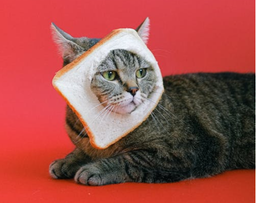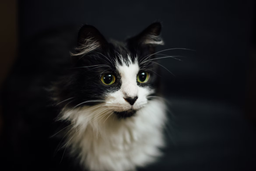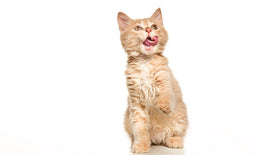Can cats eat mango? Tasty treat or a recipe for disaster?
Cat parents love to share food with their furry friends, but that’s not always the best idea. Some products are healthy for the entire family, but some may be dangerous for your kitty.
If you like mango and want to give some to your cat, check whether this sweet delight can cause gastrointestinal or any other problems for your feline. Can cats eat mango? Untamed solves the mystery.
Can cats eat mango?
The answer is yes—cats can eat mango, but it does not mean they will like it. Don't be surprised if you offer your feline friend a piece of the fruit, and they turn their head at the smell of it.
Cats are obligate carnivores and don't have taste receptors for sweetness. They probably won’t be too interested in anything other than meat, which should be the basis of your cat’s healthy diet.
Some cats might enjoy fruits and vegetables, and if your feline is one of them, mangoes are on the cat-safe list. Keep in mind that fruits and vegetables should be given to your cat in moderation because their digestive system is not designed to process plants.

Mango is a yummy snack for humans, but is it good for felines? Not really.
Source: Roman Odintsov
What's in mango, and does it provide any health benefits for cats?
Originating from India, this delicious stone fruit is loved across the globe and has become a popular ingredient in many dishes. Let's look at the nutritional value of 1 cup of chopped mango:
|
Nutrient |
Amount |
|
Fat |
6 grams |
|
Carbs |
25 grams |
|
Sugar |
23 grams |
|
Fibre |
3 grams |
|
Protein |
1 gram |
|
Vitamin A |
89 micrograms |
|
Vitamin K |
7 micrograms |
|
Vitamin C |
60 milligrams |
|
Potassium |
277 milligrams |
Mango contains a fair amount of calories (mainly sugar), so if your cat likes it, they must eat it in moderation. There are 99 calories in a cup of chopped mangoes, which is too much for your furry friend.
While mangoes contain numerous essential nutrients for humans, they are of little value to our feline companions. Cats can synthesise vitamin C and only marginally benefit from vitamin A, vitamin K, fibre, and potassium in mango. Fruits, veggies, and most human snacks can only be a treat to satisfy your kitty’s curiosity and not a substitute for their regular meals.
If you want to offer some mango as a snack, follow these steps:
- Peel the fruit because the skin is hard to digest
- Remove the pit since it's a choking hazard and contains cyanide, which is highly toxic to cats. Ingesting even the tiniest amount can make them sick
- Chop the fruit into bite-size pieces, and don't give your cat more than one tablespoon once a week
Is dried mango safe for cats?
Cats should not eat dried mango because it contains:
- Preservatives
- Too much sugar
Dried fruits usually contain more sugar than fresh ones. Artificial preservatives may also be added to the product to prevent it from spoiling, and these ingredients can hurt your cat’s digestive system.
Can kittens eat mango?
Most vets advise against feeding kittens fruit, veggies, or any type of human food (other than meat) until they are about a year old.
Their digestive systems are delicate and prone to upsets. Kittens need calorie-dense, high-protein meals to develop properly, so mango has no place in their diet.

I patiently await my snack.
Source: Quang Nguyen Vinh
My cat has eaten too much mango—what should I do?
Having too much mango may cause digestive problems in your cat since they cannot properly process fruits, veggies, or any plant-based products. Large amounts of fruits in their diet could lead to kidney damage in the long run.
Monitor their reaction to mango to spot any warning signs on time. If your cat shows the following symptoms after eating mango, they’ve likely had a reaction to the fruit:
- Diarrhoea and vomiting indicate gastrointestinal issues, meaning your cat struggles to digest the fruit
- Tooth issues come from the high sugar content in mango. They are closely tied to the regular consumption of sweet food. Cats with existing dental problems must not be given mango or any other fruit
- Heavy breathing and swelling of the face are symptoms of an allergic reaction to mango, which is not common in felines. If you notice these signs, take your cat to the vet immediately because the condition must be treated as soon as possible
Other safe fruits for felines
Even though your cat might like fruits, the nutrients in plants are not bioavailable to cats, so there are no accompanying health benefits. Fruits can be an occasional snack, while meat should be the main ingredient in your cat’s diet.
Besides mango, safe fruits for felines include:
- Pineapples
- Blueberries
- Strawberries
- Blackberries
- Bananas
- Apples
- Kiwi
- Watermelon
- Cantaloupe
Only healthy cats with no medical conditions can eat fruit. If your feline companion has diabetes, dental problems, or other health-related issues, they need to follow a strict protein diet.
The forbidden fruit
Some fruits must never be given to cats as they are toxic. The forbidden fruits can cause digestive issues, skin irritation, and other severe problems. Here’s a list of harmful fruit:
- Citrus fruits
- Grapes
- Cherries
- Persimmons
What about cats and vegetables?
Vegetables also offer little nutritional value to felines, but you can let them enjoy some veggies in moderation. If your kitty shows interest in eating vegetables, you can give them:
Some experts say that cats with digestive issues can benefit from fibre in vegetables, but there’s not enough empirical or scientific evidence to back up this claim. Before giving your cat these veggies, wash them thoroughly, remove stems and leaves, and chop them into bite-sized pieces, so they're easy to chew and swallow. Pumpkin must be peeled because the skin is toxic, while peas must be deshelled.
Toxic vegetables
The following veggies must never be given to your cat because they can cause serious harm:
Even tiny amounts will cause an upset stomach, while larger portions lead to severe illness. Cats are naturally curious, so it’s better to keep forbidden food out of their reach.
Other foods your cat shouldn’t eat
Some of our favourite food is bad for cats. The table below presents the treats you should not share with your furry friend:
|
Food |
Why it’s bad for cats |
|
Felines are usually lactose intolerant and can’t process milk and dairy. Eating dairy can cause digestive issues or an allergic reaction |
|
|
Theobromine in chocolate is toxic to cats. Eating chocolate can cause tremors, seizures and accelerated heart rate |
|
|
Caffeine |
Caffeine raises your cat’s blood pressure, causes digestive issues, and can lead to heart and nervous system damage |
|
Alcohol |
Alcohol can cause damage to your cat’s nervous system and lead to liver failure |
Food your feline will thrive on
The best diet for a healthy cat consists of animal protein and animal fat. The ideal ratio is as follows:
|
Food source |
Amount required |
|
More than 50% |
|
|
Fat |
Up to 20% |
|
Maximum 3% |
Excellent sources of all essential nutrients for your kitty are:
Vegan or vegetarian food is not appropriate for cats. Cats can break down only animal protein to get the essential amino acids, such as taurine and arginine. Check out the protein bioavailability in popular cat food ingredients in the table below:
|
Protein source |
Bioavailability score (percentage of protein your cat can absorb from a particular product) |
|
Chicken |
98% |
|
Salmon |
94% |
|
Prawns |
94% |
|
Liver |
92% |
|
Beef |
87% |
Felines absorb the maximum percentage of protein from chicken, so it’s excellent as an everyday meal. Shellfish is low in fat, high in protein, and packed with calcium, iron, zinc, and other essential minerals. Fish contains omega fatty acids, which are excellent for your furry friend’s heart, so seafood should always be included in your cat’s diet.
Beef, lamb, and pork (including ham and bacon) are high in fat and can lead to weight gain. Use them as occasional treats or natural taste enhancers in your kitty's regular meals.

Chicken and liver are excellent sources of animal protein.
Image (c) Untamed
Raw or cooked meat—what’s better for my cat?
Cook any type of meat before serving it to your cat. Wild cats eat their prey fresh, so the risk of bacterial contamination is low. Raw meat and eggs from the human supply chain get frozen and defrosted before reaching your indoor kitty’s plate, making them a fertile ground for various pathogens. Salmonella, Listeria, and E. coli are the most common ones.
If you would like to treat your furry friend to some raw chicken or any other meat, consult your vet regarding the sanitary protocols or opt for commercial B.A.R.F. products.
The benefits of animal fat
A cat’s digestive system is not good at processing carbs, so they get their energy from animal protein and animal fat.
Animal fat plays an essential role in your feline’s diet because it:
- Is super tasty to cats
- Delivers healthy fatty acids, which help utilise nutrients
- Can be a secondary energy source for cats
Fatty acids are also responsible for keeping your cat’s skin and coat healthy and shiny, building the immune system, and improving your feline friend’s vision.

What shall I be feasting on today?
Source: Cats Coming
Types of cat food on the market
There are three main types of cat food available at pet shops and supermarkets. Let’s check them out:
|
Type of food |
Description |
|
|
|
|
|
Wet food is the best option for your furry companion because it’s high in protein, low in carbs, and contains all the essential nutrients your cat needs. Vets recommend feeding your cat wet food twice a day. If your feline refuses to eat wet food that they normally enjoy, it could signal a health issue, but it’s more likely that they are in the mood for a different flavour.
To find the best quality food, look at the labels
The labels will tell you everything about the product. You need to focus on two pieces of information:
- The ingredients list states everything that is in the product. The ingredients are in descending order. Look out for food that has meat listed as the first ingredient. High-quality food has a short and easy-to-understand ingredients list
- The guaranteed analysis shows the percentage of each nutrient in the product. Every product’s guaranteed analysis must present how much protein, fat, fibre, and water the product contains. Information on other nutrients is optional
With Untamed on their plate, your cat will never crave mangoes again
Looking for healthy and delicious food for your cat? Look no further than Untamed. We love cats and make high-quality products to keep them fit and happy. Whole meat is all your cat needs, and it's all we put in our yummy dishes.
Untamed products contain twice the amount of protein as the industry standard and have been developed by vets to ensure they contain all the nutrients for your cat’s well-being.
Cats and cat parents love Untamed because:
- We use only high-quality, human-grade ingredients
- Our food is hypoallergenic
- It is an excellent source of taurine
- We gently steam our meals to preserve the nutrients and taste
Our food doesn’t contain meat derivatives, vegetables, grains, or other useless or harmful fillers because we believe a top-notch diet keeps your cat away from the vet.
If your cat is sensitive, we have single-protein-source products to keep their tummy calm. Our popular recipes for cats with digestive issues and allergies include:
- Chocka Chicken in Jelly
- Tuck-in Tuna in Jelly
To treat your cat to the feast of their life, take our short quiz and order our taster pack now.

Yummy! This is so good. I am pawsitively pleased.
Image (c) Untamed
More reasons to love Untamed
We care about our environment as much as we do about cats. Untamed uses recyclable materials and sources meat and fish from cruelty-free and dolphin-safe suppliers. Our operations leave a neutral carbon footprint because we believe in ethical food production.
Sounds great! How do I place an order?
Felines are notoriously fussy, especially about their food. We'll send you a tailor-made taster pack with 12 yummy dishes, so your cat can decide what pleases their sensitive palate. All you have to do is follow these simple steps:
- Visit our Try Now page
- Take a short quiz to tell us about your cat
- Select a meal plan and place your order
And you’re done! We’ll send the cat food trial pack to you the next day with no shipping costs. We can replenish your supplies every month at the same time. If your kitty wants to change something on the menu, you can modify the cat food subscription in a few clicks. You can also postpone or cancel your order anytime you want.
When it’s kitty’s mealtime, all you need to do is open the can and serve the meal. There is no need to freeze, defrost, or add anything extra—Untamed food is yummy and packed with all the essential nutrients your feline friend needs.
I’ve made the switch. What can I expect?
So, you’ve taken the plunge, got your Untamed meal plan, and your feline companion loves it.
You should notice significant health benefits in no time. Check out the table to see what you can expect:
|
Timeline |
What to expect |
|
One week |
|
|
Two months |
|
|
Four months |
|
|
Six months and beyond |
|
Check out our other guides to what cats can or cannot eat:
|
|

![Best food for Ragdoll cats in the UK [Broken Down]](http://untamed.com/cdn/shop/articles/featured_best_food_for_ragdoll_cats_uk.jpg?v=1646818249&width=256)

